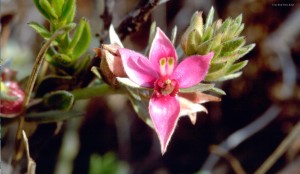Rhatany (Krameria triandra) is a plant that is fairly uncommon. The root is used as medicine. Related plants (other Krameria species) are sometimes secretly added to rhatany preparations to expand the amount of product provided.
Contents
Uses
People take rhatany for intestinal swelling (enteritis) and chest pain (angina).
Rhatany is sometimes used as a mouthwash or gargle for mild mouth and throat irritation, swollen gums, cracked tongue, and canker sores. It is also applied to the skin for leg ulcers and for swelling and itchiness caused by cold and damp weather (chilblains).
Benefits
Rhatany’s major value as a commercial good is due to krameric acid, a tannin found within the bark of the root. Tannins are a type of astringent, or substance that shrinks tissues, which constrict proteins. These chemicals are associated with the bitterness and dryness experienced when drinking some wines and teas. As this is often a sought after taste, Ratanhia has been exported, particularly to Portugal, to serve as an additive in wines.
In its medicinal uses, Ratanhia can be drunk, gargled, or applied topically as a tincture or syrup to shrink tissues throughout the body. People may drink the tincture in order to constrict tissues to restrict the flow of blood or secretions of mucous. This can be useful for patients with diarrhea or peptic ulcers, though these patients may need additional medical care in some cases. Ratanhia can also be gargled to help relieve sore throats by reducing mucous secretions. In its topical application, Krameria is often used to stem bleeding in small wounds, such as a pulled tooth or a tear in the anus.
Cautions
Rhatany is POSSIBLY SAFE for most people when taken by mouth for less than two weeks. There isn’t enough information to know if it is safe to take long-term or use on the skin. Rhatany can cause some side effects such as digestive complaints. Rarely, rhatany has caused allergic reactions in the linings of the mouth and throat.
Special Precautions & Warnings:
Pregnancy and breast-feeding: Not enough is known about the use of rhatany during pregnancy and breast-feeding. Stay on the safe side and avoid use.
Rhatany allergy: Don’t use rhatany if you are allergic to it.
Interactions
Medications taken by mouth (Oral drugs) interacts with RHATANY
Rhatany contains a large amount of chemicals called tannins. Tannins absorb substances in the stomach and intestines. Taking rhatany along with medications taken by mouth can decrease how much medicine your body absorbs, and decrease the effectiveness of your medicine. To prevent this interaction, take rhatany at least one hour after medications you take by mouth
Other names
Brazilian Rhatany, Krameria, Krameria argentea, Krameria iluca, Krameria lappacea, Krameria triandra, Mapato, Peruvian Rhatany, Pumacuchu, Raiz Para Los Dientes, Ratanhia, Ratanhiae Radix, Ratanhiawurzel, Ratanhia, Ratanhia du Brésil, Ratanhia du Chili, Ratanhia du Pérou, Ratania, Red Rhatany, Rhatanhia, Rhatania
References
Source: WiseGeek, http://www.wisegeek.com/what-is-ratanhia.htm

